From last week’s post, I got some thought-provoking questions. The main areas were: “How can I align my company with the idea journey?” and “How can I identify the right product champions to advance my projects?”
If you haven’t read it, the post covers the stages of an idea’s journey and how to leverage the right social connections at each step. You can look at this journey as the basis of most product discovery and development frameworks.
Read the post: The Idea Journey: From Concept to Reality Journey
To address these questions, I turn to a set of metrics known as a company’s entrepreneurial intensity.
What Is Entrepreneurial Intensity?
Entrepreneurial Intensity (EI), as described by Kuratko, Morris, and Covin in their book “Corporate Innovation and Entrepreneurship: Entrepreneurial Development Within Organizations,” goes beyond simply asking whether a company or individual is entrepreneurial. EI digs deeper to measure how frequently and intensely entrepreneurial activities occur within an organization. This framework examines the core behaviors and attitudes that drive true innovation and strategic risk-taking, offering a comprehensive approach to understanding and fostering entrepreneurship at both the organizational and individual levels.
EI has three dimensions: innovativeness, proactiveness, and risk-taking. Each dimension offers a window into how your organization or key individuals approach new opportunities and challenges.
Innovativeness reflects a commitment to creativity and a willingness to experiment with new ideas, processes, and products. It’s about fostering a culture where thinking outside the box isn’t just encouraged.
Proactiveness measures the ability to anticipate and act on future needs or changes in the market. A proactive organization doesn’t wait for change; it makes change happen. This forward-thinking mindset is essential for staying ahead of the competition and seizing opportunities before they become obvious to others.
Risk-taking evaluates the comfort level with uncertainty and bold decisions. It’s about understanding that significant rewards often require stepping into the unknown. Companies and individuals who embrace calculated risks are more likely to push boundaries and achieve breakthrough results.
Together, these dimensions don’t just tell us whether a company or a manager is entrepreneurial; they quantify the degree(how intense) and frequency (how often) of their entrepreneurial actions.
Understanding EI allows you to pinpoint the right individuals to champion your projects. Essentially, it’s about aligning the right mindset with the right opportunities.
Curious about how Entrepreneurial Intensity could shape your team’s approach to innovation? Let’s talk about how CRISP can help you apply these principles for real impact.
Innovativeness – Not All Innovations Are Equal
When discussing innovativeness within Entrepreneurial Intensity, it’s important to understand that not all innovations carry the same weight.
Innovativeness is not just about generating new ideas. It’s about the impact those ideas can have on your organization’s growth and competitiveness.
This metric reflects a company’s or manager’s ability to think creatively and explore novel approaches. It isn’t limited to groundbreaking, industry-shifting inventions. It can be as simple as refining processes or improving products. The key is a continuous commitment to experimentation and improvement.
Companies with high innovativeness foster an environment where creativity flourishes. These companies tend to invest in R&D, encourage cross-functional collaboration, or create a culture that celebrates small wins as much as significant breakthroughs.
It’s about an environment where thinking outside the box isn’t just a suggestion; it’s a mandate.
But here’s where it gets interesting: innovations can be incremental or radical.
Incremental innovations involve small changes or improvements, while radical innovations disrupt entire industries. Both are valuable, but it is crucial to understand which type your organization excels at (and which type is needed for a specific project).
When evaluating managers’ innovativeness, look beyond their track record of generating ideas. Consider how they approach problem-solving, how comfortable they are with ambiguity, and how they respond to failures. A truly innovative leader develops new ideas and fosters a culture where others feel empowered to do the same.
Anything New Involves Risk
Risk is always on your side when working with new ideas, so it is important to recognize that different innovation types carry different risk levels.
Types of Innovation and Corresponding Risks
- Imitation: This involves copying or adapting innovations from other companies. While it seems low risk, relying too heavily on imitation can lead to high risks.
- Continuous Innovation: Incremental improvements to existing products or services. The risk is moderate, focusing on enhancing current offerings while keeping up with market expectations. The danger lies in becoming complacent and missing opportunities for more substantial innovation.
- Dynamically Continuous Innovation: These projects create significant improvements that change consumer behavior or usage patterns, but not as drastically as discontinuous innovations. The risk here involves market acceptance and ensuring the innovation is well-timed and effectively communicated.
- Discontinuous Innovation: Breakthrough innovations that create entirely new markets or disrupt existing ones. The risks are high, from technological feasibility to market readiness. However, the rewards are equally substantial if you are successful.
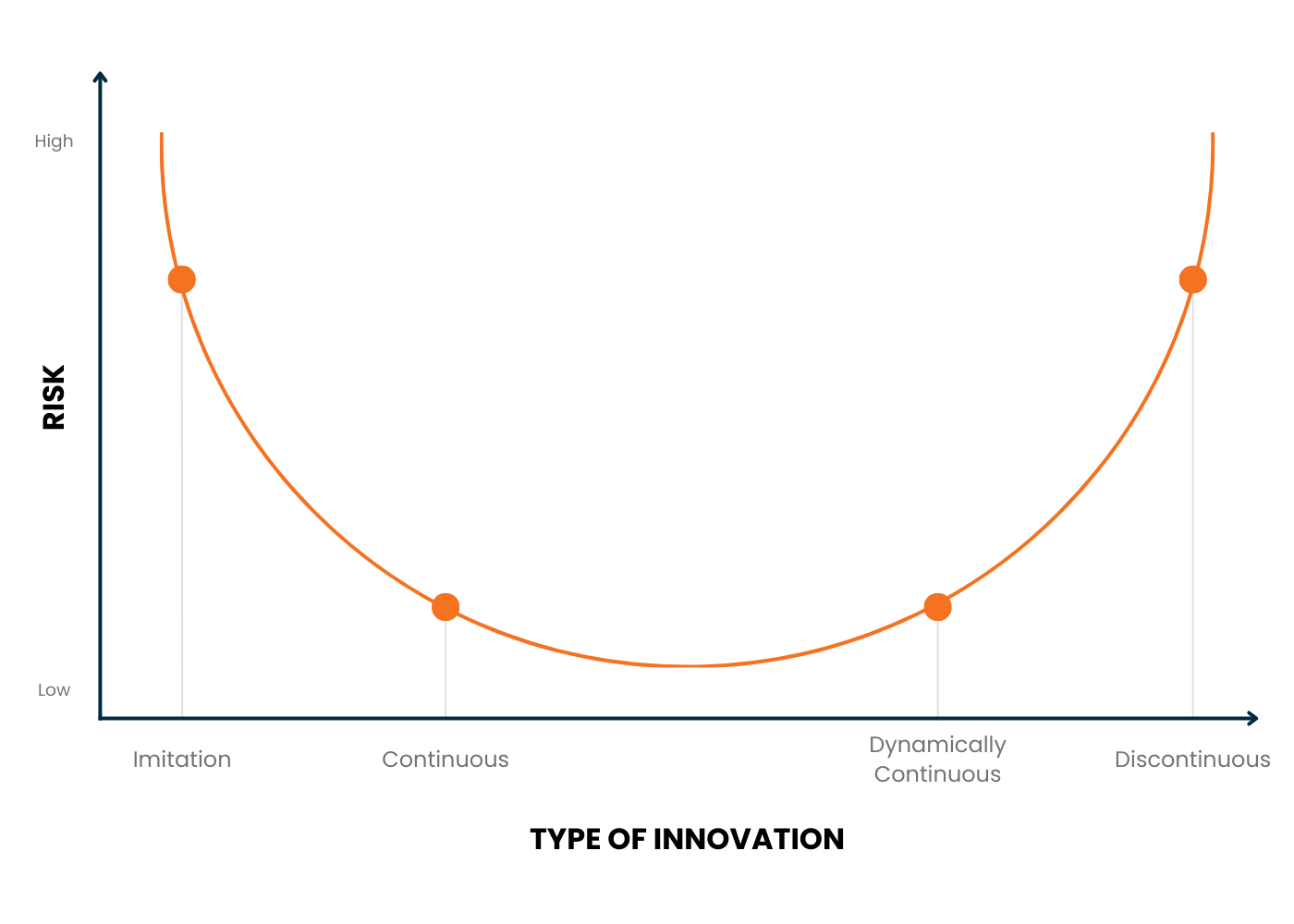
The Baseball Analogy: A Balanced Approach to Risk
Hamel and Prahalad (1994) provide a clear analogy comparing risk-taking to a baseball player perfecting their swing.
Companies that overly focus on perfecting their “swing” (developing the perfect product) often miss opportunities by moving too cautiously. Meanwhile, their competitors, who may take more swings, seize the market even if they aren’t perfect.
The lesson? Risk is better managed by coming to bat more often.
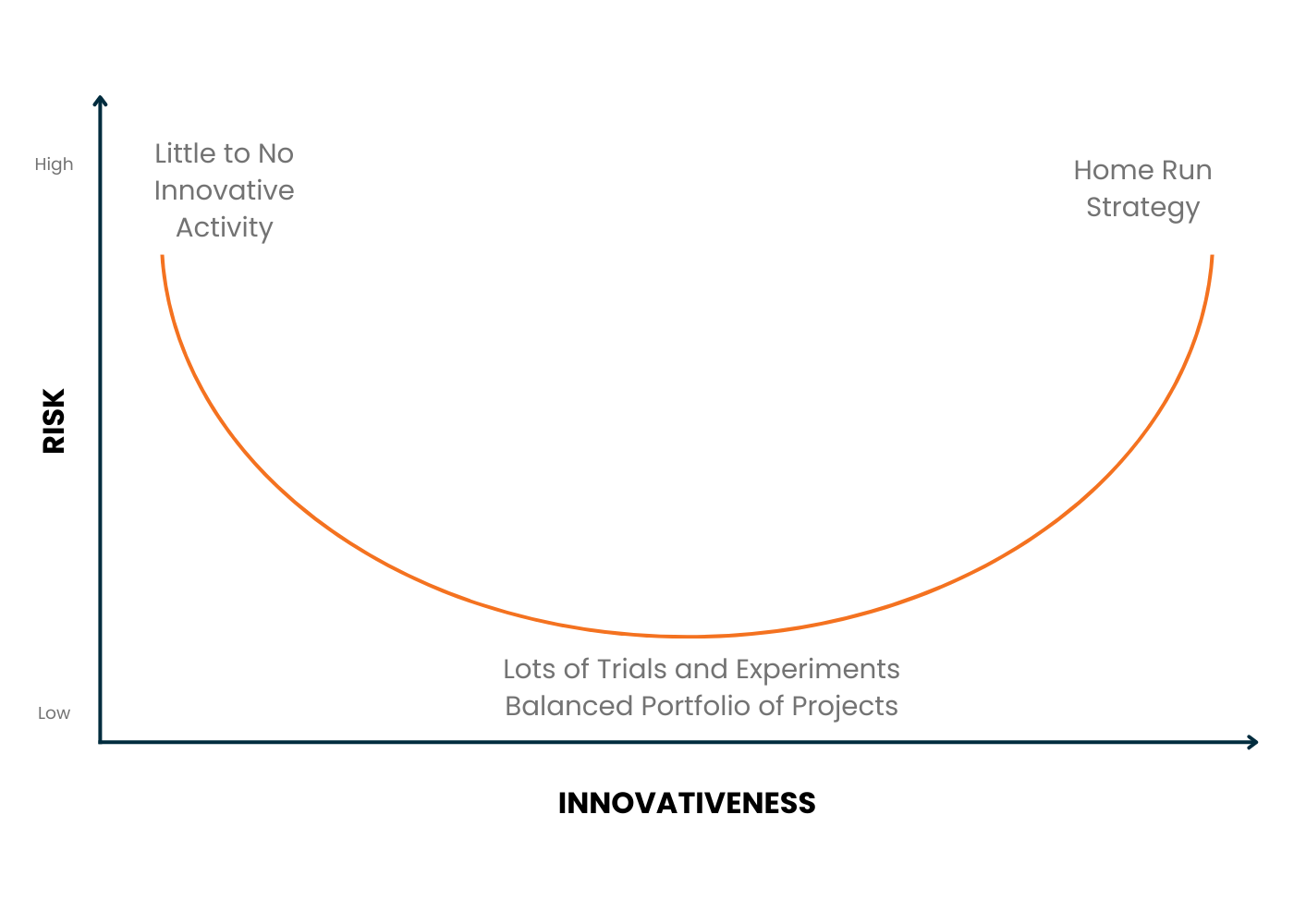
You need to pursue frequent, lower-risk initiatives or engage in higher-risk projects with a willingness to terminate those that don’t show promise quickly. This approach reduces the likelihood of “sinking the boat” while minimizing the chance of “missing the boat.”
What Are The “Sinking the Boat” and “Missing the Boat” Risks?
Dickson and Giglierano described these risks in 1996 as two dangers that must be carefully balanced when developing new products and services.
- Sinking the Boat: the risk of pursuing a concept that ultimately fails, leading to significant losses. This risk happens when a company invests heavily in a breakthrough idea that doesn’t pan out due to poor timing, misjudged market needs, or flawed execution. It’s the classic scenario of betting big and losing big.
- Missing the Boat: is the risk of being too conservative. When a company hesitates, overanalyzes, or delays action, it may miss a prime market opportunity. In this case, competitors who move faster can seize the initiative, or the market may evolve beyond the original concept, leaving the cautious company behind.
These two risks are correlated. They evolve through time and influence each other.
Early in the innovation process, the risk of sinking the boat is high, as the concept is still being refined and potential issues are being addressed. However, as time passes, the risk of missing the boat rises. Competitors may capture the market, or the window of opportunity may close, rendering the innovation obsolete.
This graph visually illustrates the balance and relationship between the two risks.
As planning time increases, the risk of sinking the boat decreases, but the risk of missing the boat rises, creating a point where total risk (TR) is minimized through careful yet timely decision-making
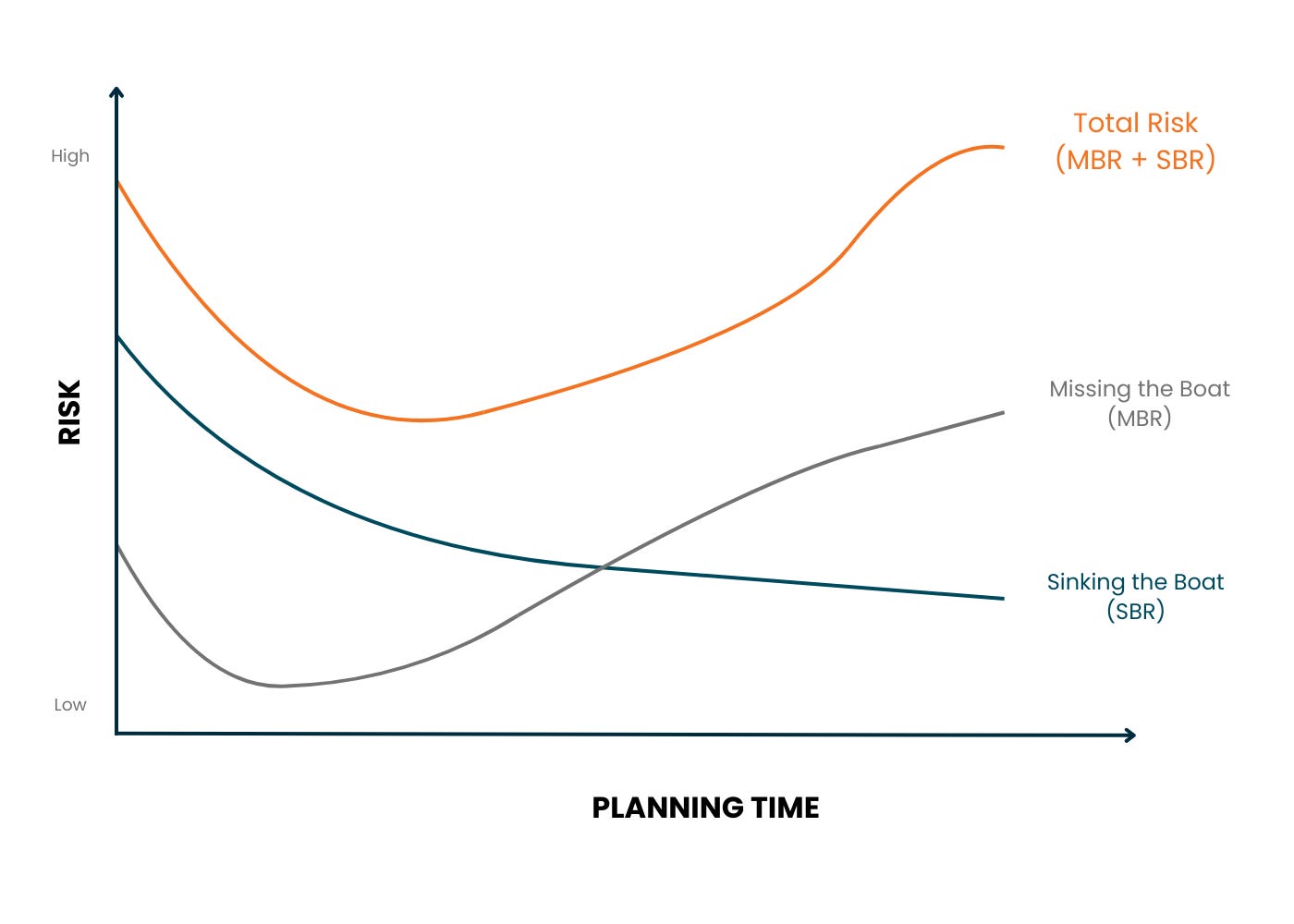
Proactiveness – More Than Just Initiative
Proactiveness, the third dimension of Entrepreneurial Intensity, goes beyond simply reacting to the environment. It embodies the idea of taking initiative and driving change within the organization and the market.
As Kuratko highlights, proactiveness is captured perfectly by the Nike slogan: “Just do it.” This dimension of entrepreneurship is about action, not reaction.
At the organizational level, proactiveness is about assertiveness in strategy. It means leading rather than following competitors, favoring growth and innovation over maintaining the status quo and taking calculated risks to outmaneuver rivals.
Proactive companies don’t wait for change; they create it. This involves continuously seeking new opportunities, launching new products ahead of the competition, and strategically eliminating declining operations.
However, proactiveness is more than just implementing solutions; it’s about perseverance and adaptability.
Take, for instance, the story of an engineer who designed a better truck bed to protect equipment during transport. While the invention was valuable, true proactiveness emerged when he had to sell the idea to management, build a coalition of supporters, and navigate organizational obstacles to implement the design.
Companies that excel in proactiveness encourage their employees to influence their environments, change their circumstances, and challenge the status quo. But being proactive doesn’t mean disregarding strategic adaptability. Research shows that the best-performing firms combine high proactiveness with the ability to adapt to new opportunities.
Combining the Metrics to Create Entrepreneurial Intensity
Entrepreneurial Intensity (EI) is more than the sum of its parts. It’s about how innovativeness, proactiveness, and risk-taking come together to shape an organization’s entrepreneurial character.
Some initiatives might be highly innovative and risky but less proactive, yet they’re still entrepreneurial. Looking at these dimensions collectively gives us a clearer picture of an organization’s overall EI. This holistic approach helps in identifying strengths, pinpointing areas for growth, and strategically aligning actions with the company’s long-term goals.
Understanding EI in this way provides a valuable framework for assessing and enhancing entrepreneurial behavior across an organization’s levels.
It’s not just about excelling in one area but about finding the right balance and ensuring that all three dimensions drive innovation and growth. When these elements are aligned, a dynamic and resilient organization is ready to seize opportunities and navigate challenges.
The Entrepreneurial Grid: Balancing Degree and Frequency
Kuratko, Morris, and Covin further expand EI by introducing the entrepreneurial grid, which is a tool that combines the degree of entrepreneurship with its frequency.
Degree refers to how innovative, risky, and proactive a company’s actions are, while frequency measures how often these entrepreneurial events occur.
The entrepreneurial grid provides a nuanced view of a company’s entrepreneurial behavior.
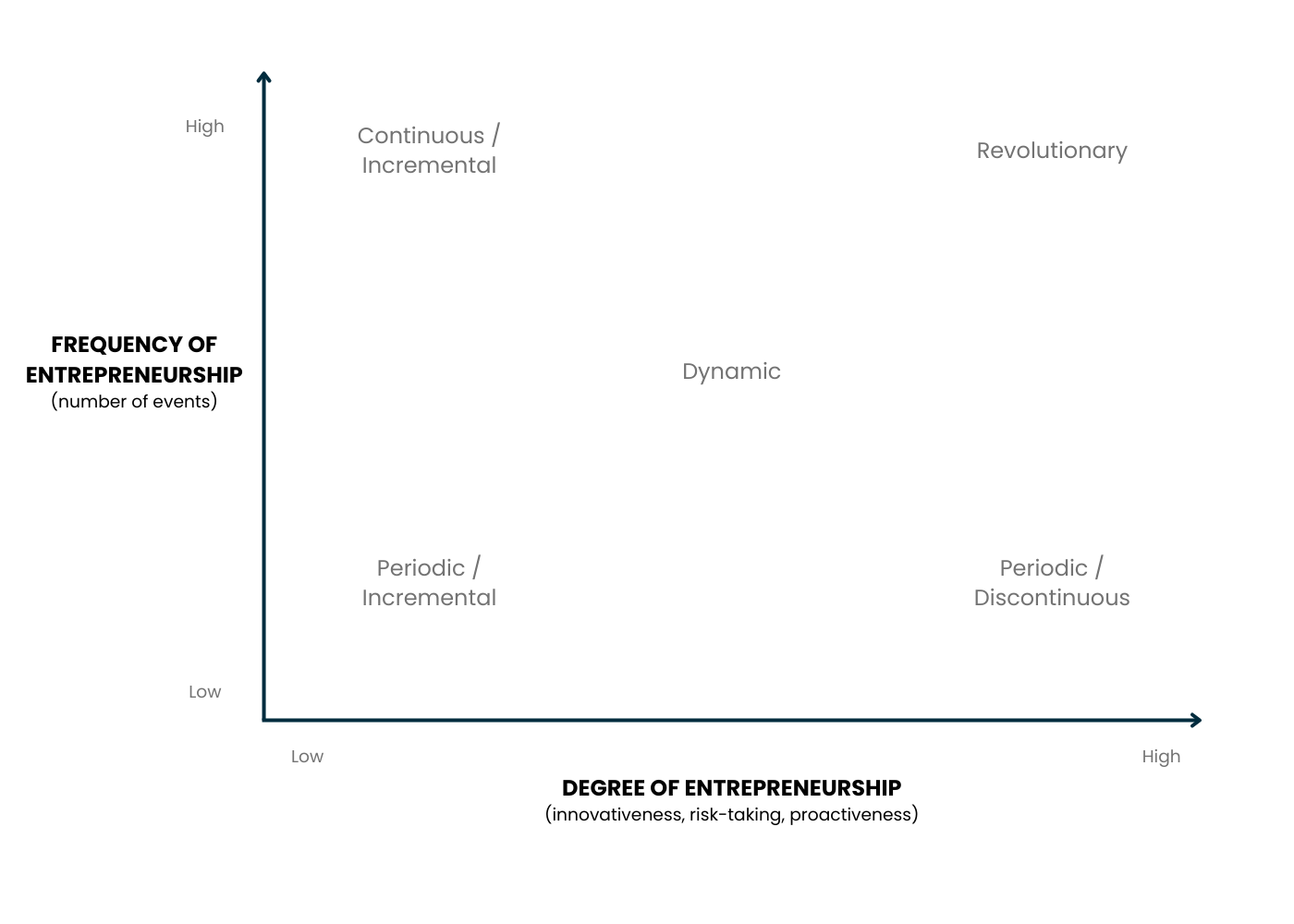
For example, a company might frequently engage in small, incremental innovations (high frequency, low degree) or focus on fewer breakthrough innovations (low frequency, high degree). Both approaches can lead to success, but understanding where your company fits on this grid helps strategize for sustainable growth.
Applying the Entrepreneurial Grid to Organizations and Managers
The entrepreneurial grid is a powerful tool for defining the role of entrepreneurship within an organization. Management can effectively outline the firm’s entrepreneurial strategy by identifying where a company falls on the grid.
Whether a company engages in frequent incremental innovations like Procter & Gamble or radical, periodic breakthroughs like Nucor, the grid helps visualize the degree and frequency of entrepreneurial activities.
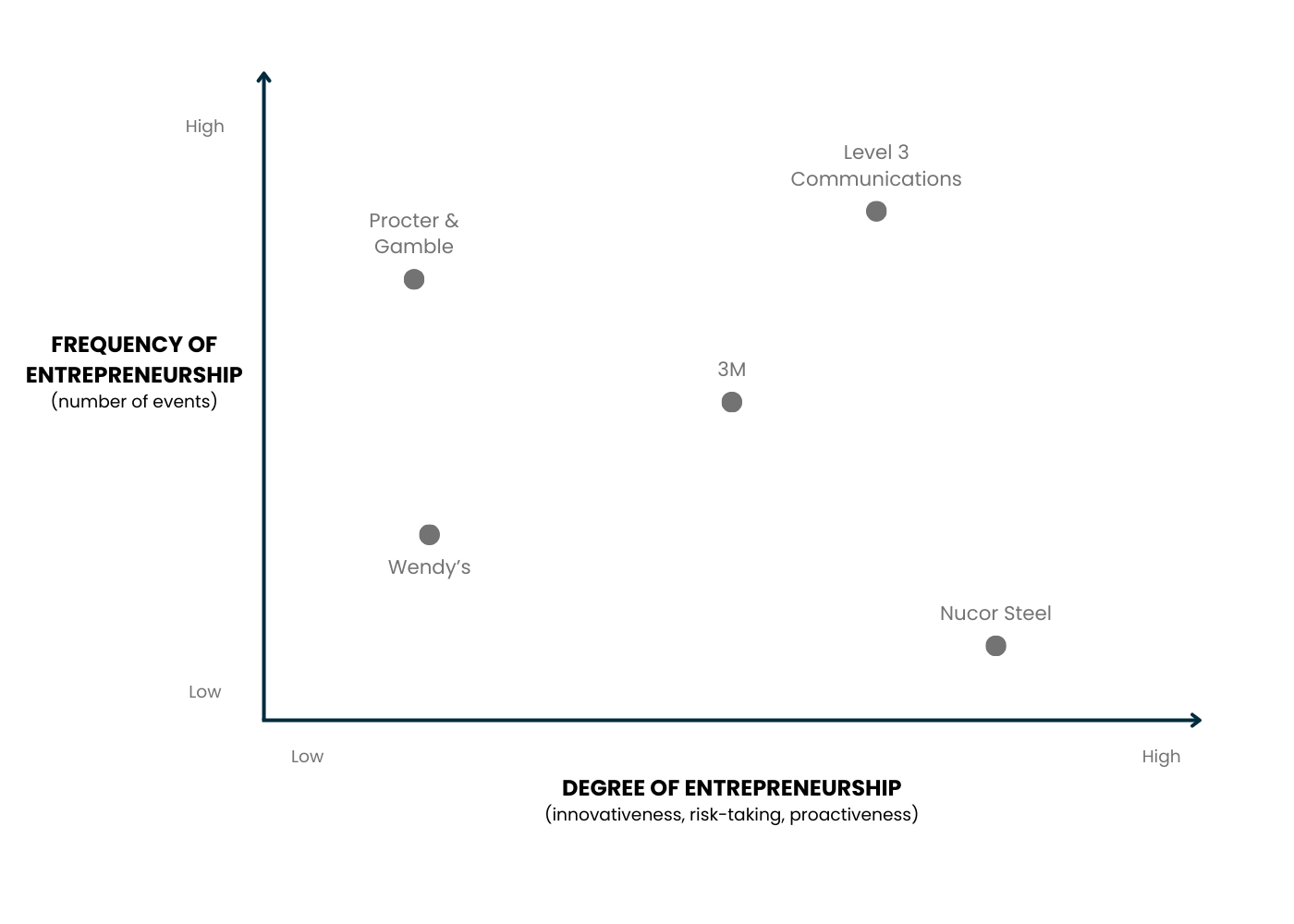
But the grid isn’t just for organizations; it also applies to individual managers. Just as companies differ in their entrepreneurial profiles, so do leaders.
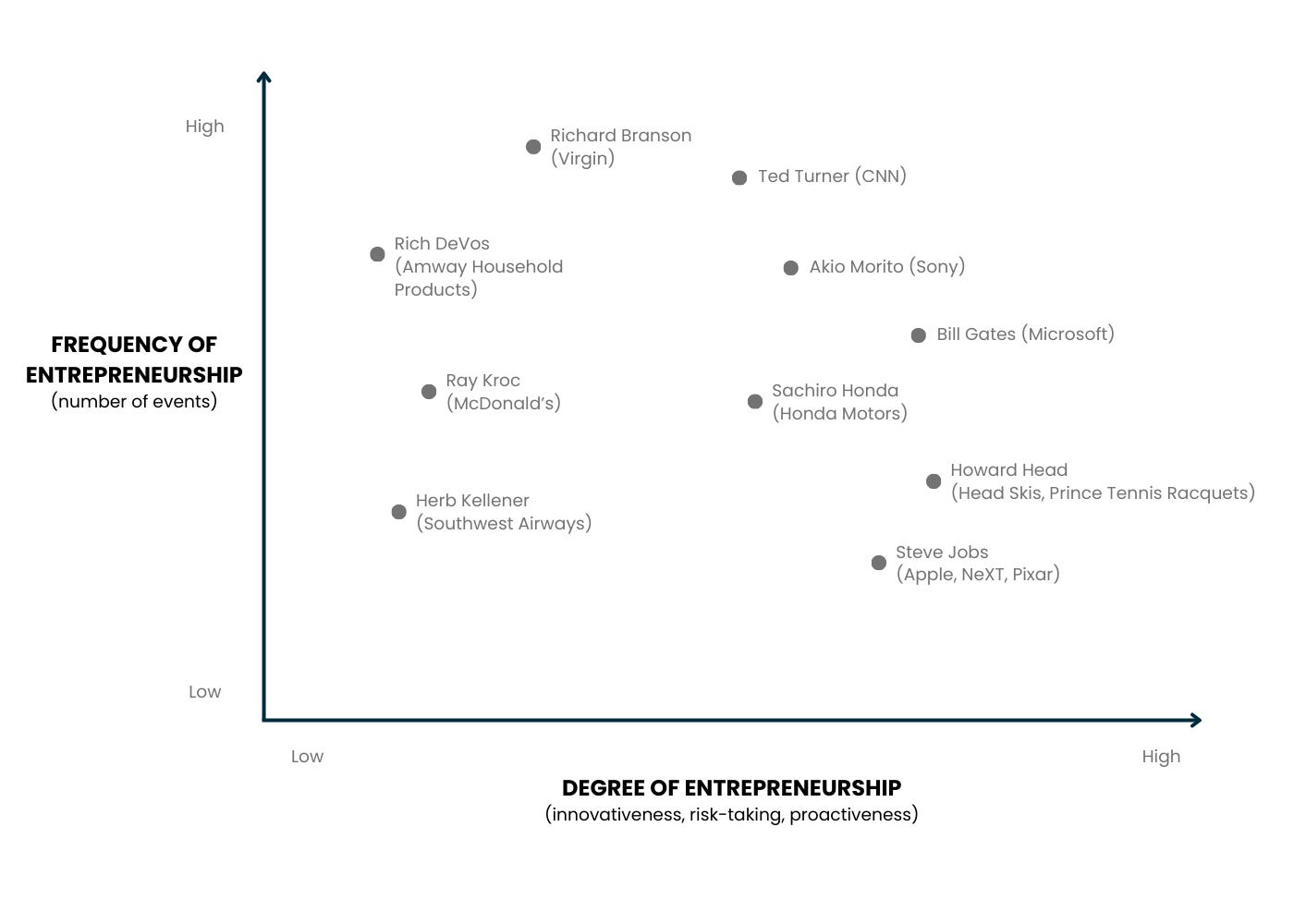
Some managers, like Bill Gates, drive dynamic, game-changing innovations, while others, like Ray Kroc, excel at adapting to environmental changes.
Organizations can better understand their strengths by mapping individual managers onto the grid and aligning them with appropriate initiatives.
How to Find the Right Product Champions
Identifying the right product champions within your organization is crucial for driving innovation and ensuring the success of new initiatives.
Product champions are individuals who understand the vision behind a project and possess the entrepreneurial qualities to bring it to life. Here’s how to find and empower them:
- Evaluate Entrepreneurial Intensity: Assess potential champions using the Entrepreneurial Intensity (EI) framework. Look for those who exhibit high innovativeness, proactiveness, and risk-taking levels. These individuals are more likely to push boundaries and drive projects forward.
- Map Managers on the Entrepreneurial Grid: Use the entrepreneurial grid to identify where managers fall in terms of degree and frequency of entrepreneurship. This map helps you select leaders who align with the project’s specific needs, whether requiring frequent incremental innovations or breakthrough, high-risk initiatives.
- Align with Strategic Goals: Ensure that the product champions you select clearly understand the company’s long-term goals and are committed to aligning their efforts with these objectives. Champions should be both visionary and pragmatic, balancing innovation with strategic intent.
- Empower and Support: Once identified, product champions need the right support. Provide them with the resources, autonomy, and backing they need to succeed. This includes access to cross-functional teams, decision-making authority, and a clear mandate from leadership.
- Monitor and Adapt: Regularly assess your product champions’ performance and alignment with the entrepreneurial strategy. The dynamic nature of the entrepreneurial grid means that needs may change, champions may need to adapt, or new champions may need to be identified.
Unlock Your Team’s Entrepreneurial Potential with CRISP
Entrepreneurial Intensity (EI) is a powerful tool for aligning your strategy with your organization’s capacity for innovation and growth. By assessing how your company’s innovativeness, proactiveness, and risk-taking intersect, you can discover new opportunities and empower the right leaders to advance your critical projects.
At CRISP, we specialize in helping organizations like yours harness their entrepreneurial potential. Whether you’re looking to foster a culture of innovation, identify key product champions, or drive impactful change, our tailored solutions can make it happen.
Ready to see what EI can do for your business? Book a free consultation with CRISP today and discover how we can support your journey toward sustainable growth and competitive advantage.







